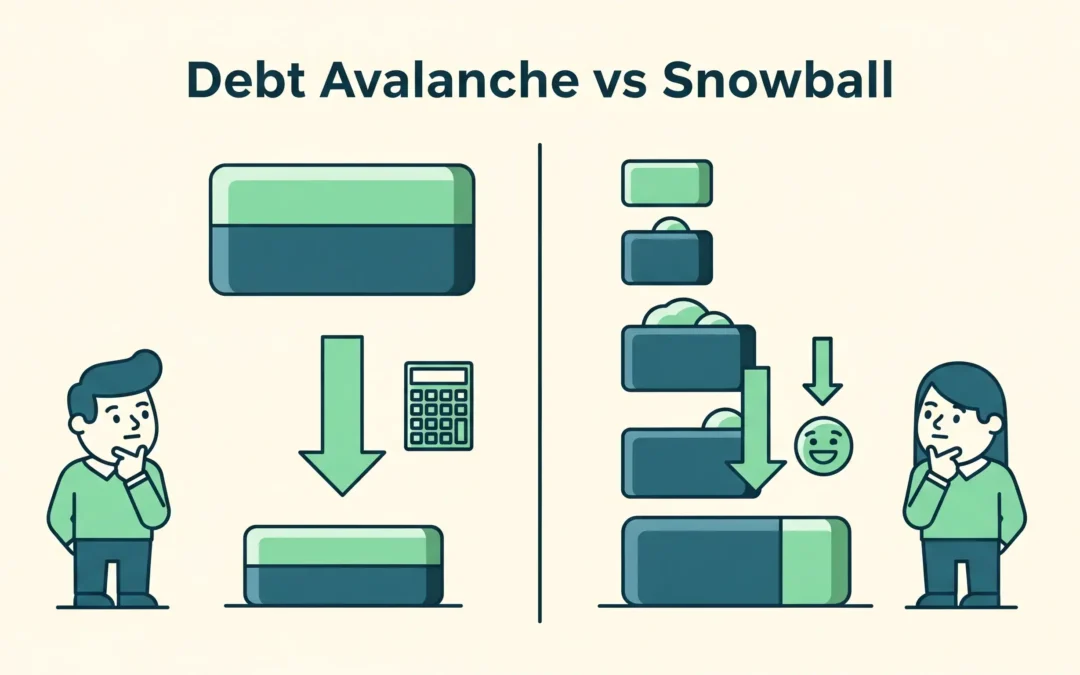Organising your debts can be a daunting and stressful task, particularly when you’re balancing several payments, interest rates, and due dates. However, attaining debt freedom becomes much more motivating and manageable with the correct approach. The Debt Avalanche and the Debt Snowball are two well-liked debt repayment strategies that can help with that. These tactics provide two different methods for paying off debt, each with advantages for psychology and logic. One prioritises reducing interest expenses, while the other places more emphasis on gaining momentum through rapid victories.
This article will explain each approach, and you can choose the better one.
What is the Debt Avalanche Method?
When applying the debt avalanche method, you should pay off the debts with the highest interest rates first, regardless of the remaining balance. The objective is to pay as little interest as possible and pay off debt as quickly as possible. Like an avalanche gathering speed, you can gradually pay off each loan in order of decreasing interest by focusing on the most expensive one first and making minimum payments on the others. For those who are focused on long-term savings and are financially disciplined, this approach is perfect.
Essential Elements of the Debt Avalanche Approach:
- It focuses on debt with the highest interest rates first to save the most money on interest over time.
- It can reduce your total interest paid compared to the snowball method, particularly if your debts have significantly different interest rates. The actual savings depend on your specific balances and interest rates.
- It is quicker debt repayment for those who can contribute more money each month
- It demands perseverance and self-control because early victories might not be evident right away.
Example:
| Debt Type | Balance | Interest Rate | Minimum Payment |
| Credit Card A | ₹30,000 | 18% | ₹1,200 |
| Personal Loan | ₹50,000 | 12% | ₹2,000 |
| Education Loan | ₹1,00,000 | 7% | ₹3,000 |
Step 1: Make minimum payments on all loans:
- Total minimum = ₹1,200 + ₹2,000 + ₹3,000 = ₹6,200
Step 2: Assume you can pay ₹8,200 monthly. That’s ₹2,000 extra.
Put the extra ₹2,000 toward the credit card (18%), your highest interest debt.
Step 3: New payment on Credit Card A = ₹1,200 + ₹2,000 = ₹3,200/month
With this strategy, Credit Card A will be paid off in about 10–11 months instead of 18+ months, saving thousands in interest. Then, you roll that full ₹3,200 to the next highest-interest debt (Personal Loan), accelerating the repayment like an avalanche.
What is the Snowball Method?
The Debt Snowball Method is a popular debt repayment strategy that emphasises paying off your smallest debt first, regardless of interest rates. You can maintain your commitment to paying off all of your debts by gaining momentum and motivation by swiftly paying off smaller balances. Like a snowball that gets bigger as it rolls, you roll the payment amount from each debt you pay off into the next smallest debt.
Essential Elements of the Debt Snowball Approach:
- Debt Snowball Method prioritises debts from smallest to largest balances, which results in a feeling of quick wins.
- It increases confidence and builds motivation by paying off debts more quickly.
- It calls for paying the minimum amount due on all other debts while focusing additional funds on the smallest debt.
- Easy to follow and psychologically satisfying, particularly for people who have trouble maintaining their motivation.
| Debt Type | Balance (₹) | Interest Rate | Minimum Payment (₹) |
| Credit Card | 20,000 | 18% | 1,000 |
| Personal Loan | 50,000 | 12% | 2,000 |
| Education Loan | 1,00,000 | 7% | 3,000 |
Step 1: Make the minimum payments on all of your debts and apply any additional funds to your credit card, which is the smallest debt.
Let’s say you have ₹5,000 to spare each month, but your combined minimum payments total ₹6,000 (₹1,000 for the credit card, ₹2,000 for the personal loan, and ₹3,000 for the education loan).
You must always pay at least the minimum due on every debt each month to avoid penalties and harming your credit. If you can’t cover all minimums, contact your lenders for hardship assistance; do not start either strategy until you can make all minimum payments.
Step 2: Prioritise using additional funds to pay off the credit card. Transfer the full ₹5,000 payment amount to the personal loan after the ₹20,000 credit card debt has been paid off.
Step 3: Roll over the ₹5,000 payment to the Education Loan until it is paid in full after the Personal Loan has been cleared.
Debt Avalanche vs Snowball: Which Is Better?
| Feature | Debt Avalanche | Debt Snowball |
| Strategy | Pay the debt with the highest interest first | Pay according to the balance amount, i.e., the smallest balance first |
| Interest Paid | Lower | Higher |
| Motivation | Logical, it may take time to feel progress | Quick wins, higher emotional payoff |
| Speed of Repayment | Usually, faster | Slower if high-interest debts are large |
| Ideal For | People are good with discipline and numbers | People needing psychological encouragement |
Bottomline
To conclude, there is no one-size-fits-all method for repaying debt; rather, it is contingent upon personal preferences, financial practices, and psychological triggers. While some might flourish on the Debt Snowball’s emotional drive, others might profit from the Debt Avalanche’s logical efficiency. The most crucial thing is to begin your journey, maintain consistency, and firmly resolve to pay off your debt. The first and most effective step to financial freedom is taking action, regardless of whether you’re motivated by momentum or numbers.
Written by: Tanya Kumari


